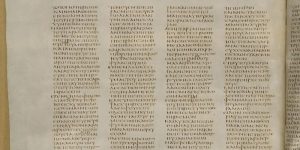
“I never read the New Testament before. I found it to be a very interesting book.”
A few years back one of my students wrote these words at the bottom of his final exam in a course in New Testament. He had been raised in the church. Throughout his church services, Sunday school classes and youth group events, there was never a time when he was taught to read all of Scripture. Although well-educated, adept at the English language and a person of true faith, he never read the New Testament.
I’m glad he found it to be a very interesting book.
Reading in the Ancient World
“Until I arrive, give attention to the public reading of scripture, to exhorting, to teaching” (1 Timothy 4:13). Young Timothy was Paul’s protégé, and the apostle sent this instruction to him as part of his charge to lead the church in Ephesus. The congregation, principally Gentiles, did not have any foundations in Scripture. “Reading” meant reading aloud the Old Testament translated into Greek. It was called the Septuagint (commonly abbreviated as LXX). How could the Ephesian congregation ever understand the significance of the cross and resurrection of Christ if they had not read about creation and fall in Genesis or the great hope of redemption laid out in Isaiah 53?
The church followed the practice of the synagogue where the law and the prophets were read aloud each Sabbath. One ancient inscription identifies “the synagogue” as the place “for the public reading of the Law.”
Reading and interpreting
Reading was commonly done aloud in those days. Indeed, ancient authors expected that their works would be read out loud and paid careful attention to the sound of their writings. Acts 8 illustrates the practice of oral reading. An Ethiopian official read aloud from the scroll of Isaiah as he traveled back home from Jerusalem in his chariot. Philip heard him, ran up and asked, “Do you understand what you are reading?” The man replied, “How can I, unless someone guides me?” Philip started from the passage he was reading, Isaiah 53:7-8, and “proclaimed to him the good news about Jesus” (Acts 8:26-40).
It was always about reading the text and interpreting. Listening was followed by explanation, reading gave way to interpretation. We call the whole process hermeneutics, exegesis and contextualization, moving from Scripture to theological relevance.
Jesus showed the way. At the beginning of his ministry, he was at his synagogue in Nazareth where the scroll of Isaiah was placed on the bema. He unrolled it and found the text we know as Isaiah 61: “The Spirit of the Lord is upon me, because he has anointed me to bring good news to the poor….” He sat down and interpreted the text for them: “Today the Scripture has been fulfilled in your hearing.” (Luke 4:16-30). It’s text and interpretation, all the way down.
The apostle Paul was severely torn between his calling to preach the gospel throughout the Roman Empire and his loving concern for the well-being and maturity of all the new believers. He longed to revisit churches to fill up what was lacking in their faith (1 Thessalonians 3:10), he sent them his associates like Titus and Timothy, and he wrote an abundance of letters that were to be read aloud to the churches. “I solemnly command you by the Lord that this letter be read to all of them,” he said to the Thessalonians (5:27).
What’s on your bookshelf?

We have the added privilege today of living in a highly literate society, and we enjoy the work of Bible translators who take the text written in Hebrew, Aramaic and Greek and translate them into our language and the languages of the world. The NIV, NRSV, CEB, ESV, CSB, NLT, and a myriad of others are available in print and online (www.biblegateway.com). Additionally, we have an overabundance of excellent commentaries that help us understand the meaning of Scripture (see www.bestcommentaries.com). On top of the translations and commentaries, we have Christian colleges, universities and seminaries that faithfully teach Scripture and its interpretation (I’m partial to Trinity International University – Florida!). And we have well-educated and spiritual men and women who read and teach Scripture in our churches week after week.
Reading the gospel
In recent years I’ve started each class with the declaration that I have one goal in the course: to teach each person the gospel of Jesus Christ. I have an urgency about this like never before as our brothers and sisters are swept away by rumors, shallow ideas not rooted in Scripture, conspiracy theories, and values more reflective of our cultural contexts than the Word of the Lord. I’m fearful for the church, deeply concerned for her future and well-being, since she reads so little Scripture and understands so little of its meaning. Many get swept away, “tossed to and fro and blown about by every wind of doctrine, by peoples’ trickery, by their craftiness in deceitful scheming” (Ephesians 4:14).
I knew the great Christian teacher the of 20th century, Dr. John Stott. For years I heard him speak about the urgency of helping Christians become mature in the faith. He espoused the “Langham Logic,” named after the street where his church in London was located. It goes like this:
- God wants his church to grow up to maturity.
- The people of God grow through the Word of God.
- The Word of God comes to people mainly (not exclusively) through biblical preaching.
Paul gave the same idea to Timothy – and to us: “Until I arrive, give attention to the public reading of scripture, to exhorting, to teaching.”
 Dr. Gene L. Green is the Dean of Trinity International University – Florida. Visit them at tiu.edu/florida
Dr. Gene L. Green is the Dean of Trinity International University – Florida. Visit them at tiu.edu/florida
Read last month’s article by Dr. Gene L. Green at: https://www.goodnewsfl.org/the-art-deception-and-the-art-of-discernment/

Comments